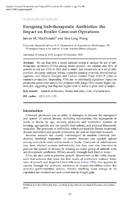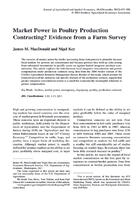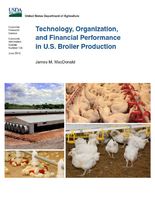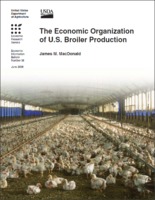Browse Items: 4
Foregoing Sub-therapeutic Antibiotics: the Impact on Broiler Grow-out Operations
We use data from a recent national survey to analyze the use of sub-therapeutic antibiotics (STAs) among broiler growers. We estimate that 42% of growers do not use STAs in their feed or water, and instead rely on a set of other practices, including pathogen testing, expanded sanitary protocols, altered feeding regimens, and Hazard Analysis and…
Market Power in Poultry Production Contracting? Evidence from a Farm Survey
The exercise of market power by broiler processing firms (integrators) is plausible because local markets for growers are concentrated and because growers face hold-up risks arising from substantial investments in specific assets set against limited integrator purchase commitments. This article explores the links between local integrator…
Technology, Organization, and Financial Performance in U.S. Broiler Production
Between 1960 and 1995, U.S. broiler production grew by 5.6 percent per year, but a lack of growth since 2008 has placed new financial pressures on contract growers. This report uses USDA survey data to delineate the key features of the industry’s organization and to analyze its recent financial and productive performance.
The Economic Organization of U.S. Broiler Production
Broiler production in the United States is coordinated almost entirely through systems of production contracts, in which a grower’s compensation is based, in part, on how the grower’s performance compares with that of other growers. The industry is undergoing a gradual structural change as production shifts to larger broiler enterprises that…
 An official website of the United States government.
An official website of the United States government.





